Project Management: Functional Analysis of Bullet Train Project
VerifiedAdded on 2022/10/04
|15
|3001
|14
Report
AI Summary
This report provides a comprehensive analysis of functional analysis and allocation within the context of project management, specifically using the bullet train construction and operation program as a case study. It begins with an introduction that emphasizes the importance of effective project man...
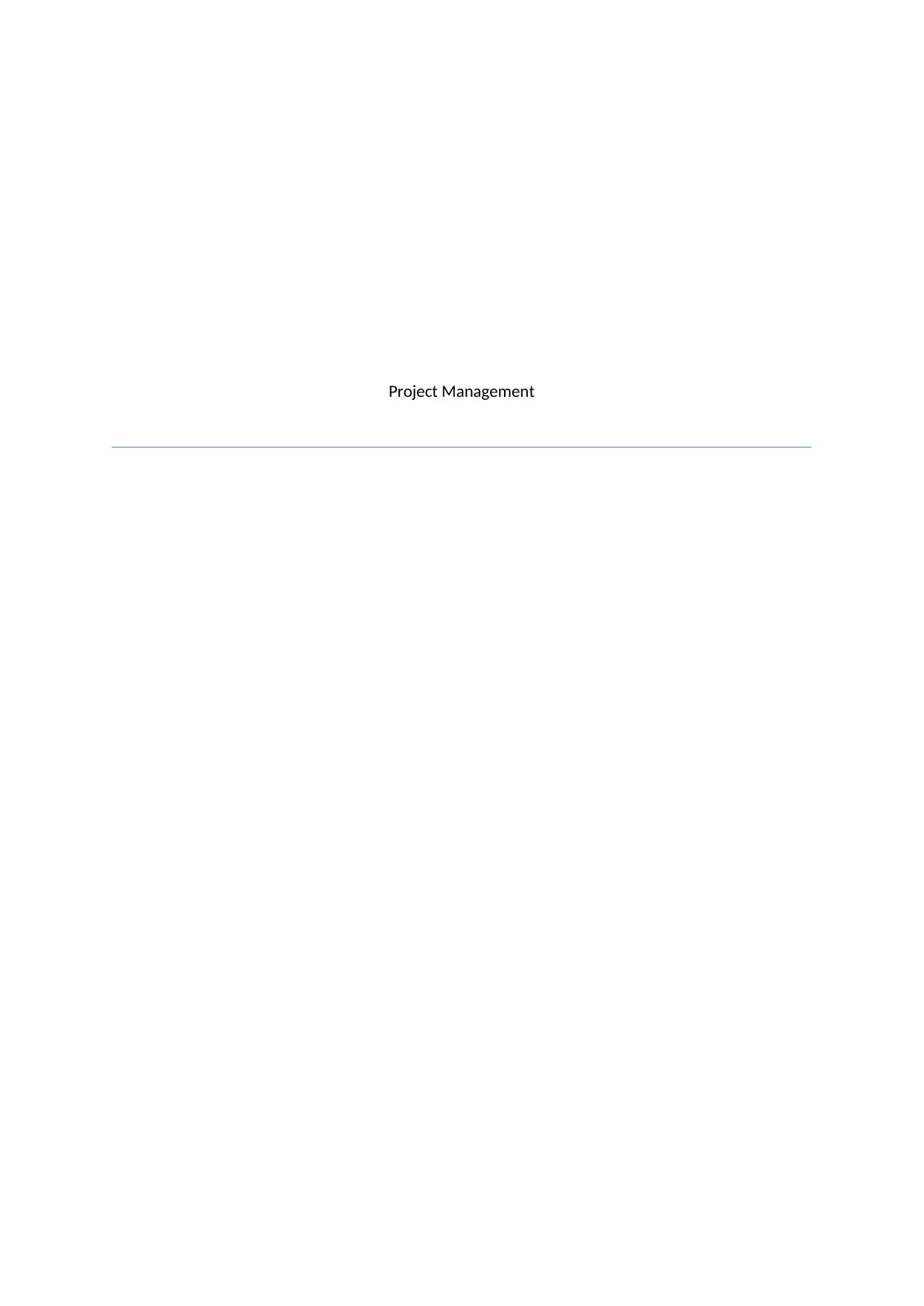
Project Management
Paraphrase This Document
Need a fresh take? Get an instant paraphrase of this document with our AI Paraphraser
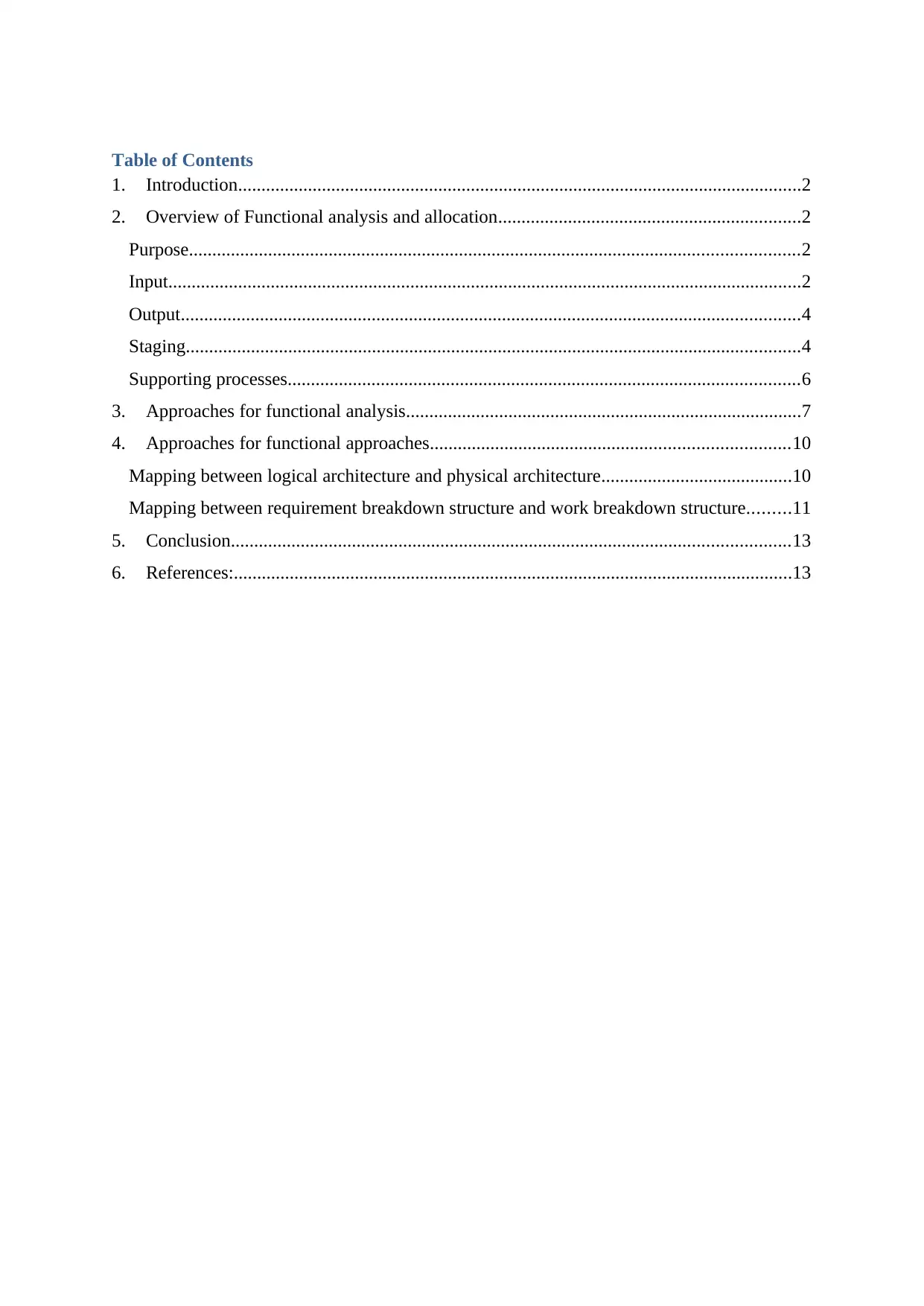
Table of Contents
1. Introduction.........................................................................................................................2
2. Overview of Functional analysis and allocation.................................................................2
Purpose...................................................................................................................................2
Input........................................................................................................................................2
Output.....................................................................................................................................4
Staging....................................................................................................................................4
Supporting processes..............................................................................................................6
3. Approaches for functional analysis.....................................................................................7
4. Approaches for functional approaches.............................................................................10
Mapping between logical architecture and physical architecture.........................................10
Mapping between requirement breakdown structure and work breakdown structure.........11
5. Conclusion........................................................................................................................13
6. References:........................................................................................................................13
1. Introduction.........................................................................................................................2
2. Overview of Functional analysis and allocation.................................................................2
Purpose...................................................................................................................................2
Input........................................................................................................................................2
Output.....................................................................................................................................4
Staging....................................................................................................................................4
Supporting processes..............................................................................................................6
3. Approaches for functional analysis.....................................................................................7
4. Approaches for functional approaches.............................................................................10
Mapping between logical architecture and physical architecture.........................................10
Mapping between requirement breakdown structure and work breakdown structure.........11
5. Conclusion........................................................................................................................13
6. References:........................................................................................................................13

1. Introduction
Project success can be determined by identifying the effectiveness and efficiency of the
project management techniques and tools applied for the completion of the project. Business
operations can be streamlined by defining the clear goal and objectives. Requirements are
traced with respect to project mission and vision of expected outcome. In this paper, we will
identify the functional analysis and allocation by determining the facts from bullet train
operation program.
2. Overview of Functional analysis and allocation
Purpose
Functionality of the project is determined for managing the division of tasks, activities, role
and responsibilities, and expected outcome of the project (Raz, Shenhar, and Dvir, 2011).
Complexities of the system can be resolved by deploying the functional analysis and
allocation because it defines the requirement breakdown structure and work breakdown
structure which helps in determining the quality of the expected outcome. Difference between
the expectation and actual work can be resolved by applying the functional allocation and
approach. Functional analysis, approach, and allocation is used for enhancing the
construction and operational program of bullet train to improve the transportation system.
Input
The stakeholder engagement program is developed so that distribution of responsibilities can
be effectively done to meet the end result of the project. Success of the project depends on the
effective utilization of men, money, method, material, and management. Designing of the
requirement breakdown structure helps in evaluating the operational and constructional need
of the bullet train program (Saxena, 2016). Requirement breakdown structure of the bullet
train construction and operation program is defined below:
Figure 1: Requirement Breakdown structure
Project success can be determined by identifying the effectiveness and efficiency of the
project management techniques and tools applied for the completion of the project. Business
operations can be streamlined by defining the clear goal and objectives. Requirements are
traced with respect to project mission and vision of expected outcome. In this paper, we will
identify the functional analysis and allocation by determining the facts from bullet train
operation program.
2. Overview of Functional analysis and allocation
Purpose
Functionality of the project is determined for managing the division of tasks, activities, role
and responsibilities, and expected outcome of the project (Raz, Shenhar, and Dvir, 2011).
Complexities of the system can be resolved by deploying the functional analysis and
allocation because it defines the requirement breakdown structure and work breakdown
structure which helps in determining the quality of the expected outcome. Difference between
the expectation and actual work can be resolved by applying the functional allocation and
approach. Functional analysis, approach, and allocation is used for enhancing the
construction and operational program of bullet train to improve the transportation system.
Input
The stakeholder engagement program is developed so that distribution of responsibilities can
be effectively done to meet the end result of the project. Success of the project depends on the
effective utilization of men, money, method, material, and management. Designing of the
requirement breakdown structure helps in evaluating the operational and constructional need
of the bullet train program (Saxena, 2016). Requirement breakdown structure of the bullet
train construction and operation program is defined below:
Figure 1: Requirement Breakdown structure
You're viewing a preview
Unlock full access by subscribing today!
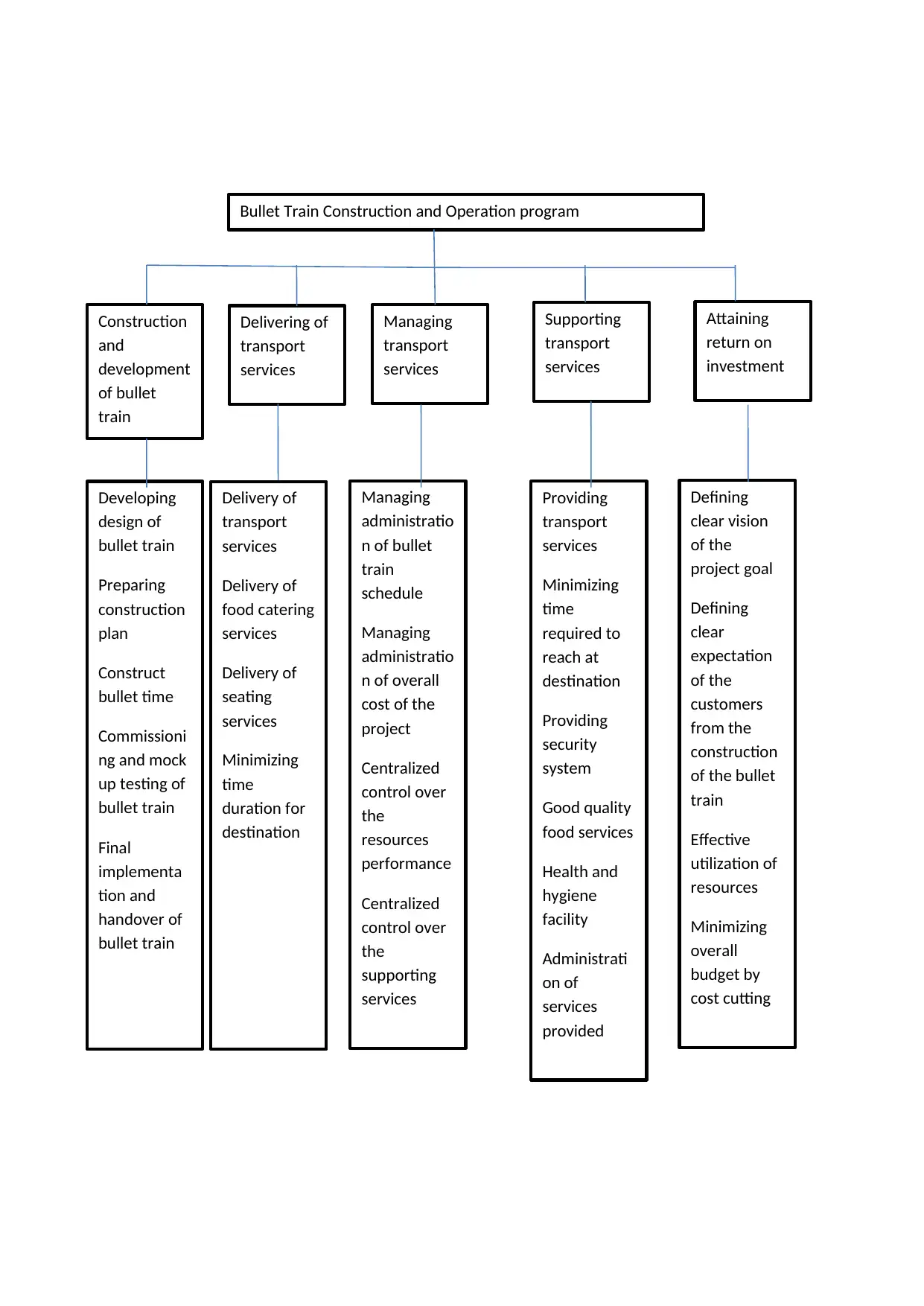
Bullet Train Construction and Operation program
Construction
and
development
of bullet
train
Delivering of
transport
services
Managing
transport
services
Supporting
transport
services
Attaining
return on
investment
Developing
design of
bullet train
Preparing
construction
plan
Construct
bullet time
Commissioni
ng and mock
up testing of
bullet train
Final
implementa
tion and
handover of
bullet train
Delivery of
transport
services
Delivery of
food catering
services
Delivery of
seating
services
Minimizing
time
duration for
destination
Managing
administratio
n of bullet
train
schedule
Managing
administratio
n of overall
cost of the
project
Centralized
control over
the
resources
performance
Centralized
control over
the
supporting
services
Providing
transport
services
Minimizing
time
required to
reach at
destination
Providing
security
system
Good quality
food services
Health and
hygiene
facility
Administrati
on of
services
provided
Defining
clear vision
of the
project goal
Defining
clear
expectation
of the
customers
from the
construction
of the bullet
train
Effective
utilization of
resources
Minimizing
overall
budget by
cost cutting
Construction
and
development
of bullet
train
Delivering of
transport
services
Managing
transport
services
Supporting
transport
services
Attaining
return on
investment
Developing
design of
bullet train
Preparing
construction
plan
Construct
bullet time
Commissioni
ng and mock
up testing of
bullet train
Final
implementa
tion and
handover of
bullet train
Delivery of
transport
services
Delivery of
food catering
services
Delivery of
seating
services
Minimizing
time
duration for
destination
Managing
administratio
n of bullet
train
schedule
Managing
administratio
n of overall
cost of the
project
Centralized
control over
the
resources
performance
Centralized
control over
the
supporting
services
Providing
transport
services
Minimizing
time
required to
reach at
destination
Providing
security
system
Good quality
food services
Health and
hygiene
facility
Administrati
on of
services
provided
Defining
clear vision
of the
project goal
Defining
clear
expectation
of the
customers
from the
construction
of the bullet
train
Effective
utilization of
resources
Minimizing
overall
budget by
cost cutting
Paraphrase This Document
Need a fresh take? Get an instant paraphrase of this document with our AI Paraphraser
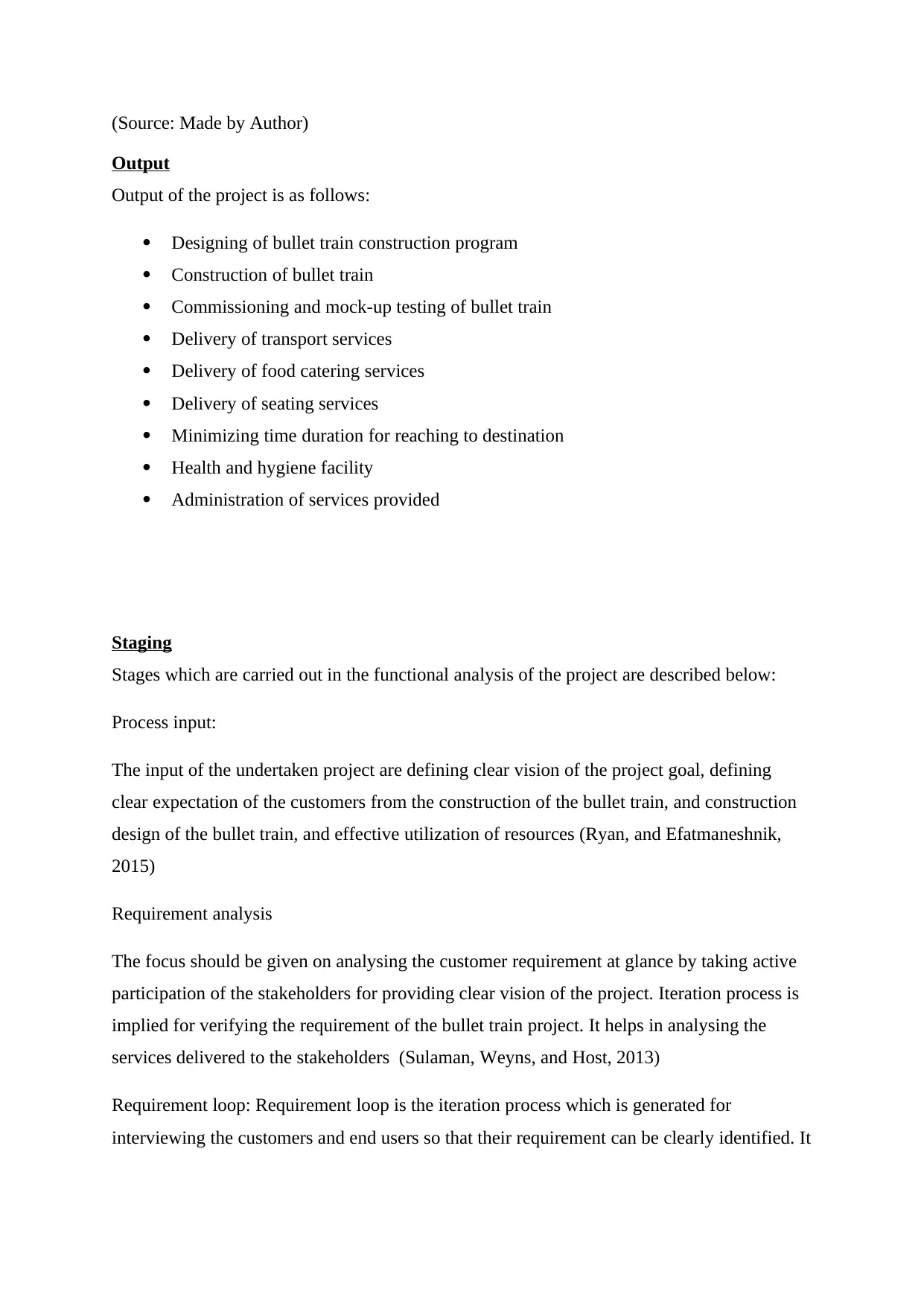
(Source: Made by Author)
Output
Output of the project is as follows:
Designing of bullet train construction program
Construction of bullet train
Commissioning and mock-up testing of bullet train
Delivery of transport services
Delivery of food catering services
Delivery of seating services
Minimizing time duration for reaching to destination
Health and hygiene facility
Administration of services provided
Staging
Stages which are carried out in the functional analysis of the project are described below:
Process input:
The input of the undertaken project are defining clear vision of the project goal, defining
clear expectation of the customers from the construction of the bullet train, and construction
design of the bullet train, and effective utilization of resources (Ryan, and Efatmaneshnik,
2015)
Requirement analysis
The focus should be given on analysing the customer requirement at glance by taking active
participation of the stakeholders for providing clear vision of the project. Iteration process is
implied for verifying the requirement of the bullet train project. It helps in analysing the
services delivered to the stakeholders (Sulaman, Weyns, and Host, 2013)
Requirement loop: Requirement loop is the iteration process which is generated for
interviewing the customers and end users so that their requirement can be clearly identified. It
Output
Output of the project is as follows:
Designing of bullet train construction program
Construction of bullet train
Commissioning and mock-up testing of bullet train
Delivery of transport services
Delivery of food catering services
Delivery of seating services
Minimizing time duration for reaching to destination
Health and hygiene facility
Administration of services provided
Staging
Stages which are carried out in the functional analysis of the project are described below:
Process input:
The input of the undertaken project are defining clear vision of the project goal, defining
clear expectation of the customers from the construction of the bullet train, and construction
design of the bullet train, and effective utilization of resources (Ryan, and Efatmaneshnik,
2015)
Requirement analysis
The focus should be given on analysing the customer requirement at glance by taking active
participation of the stakeholders for providing clear vision of the project. Iteration process is
implied for verifying the requirement of the bullet train project. It helps in analysing the
services delivered to the stakeholders (Sulaman, Weyns, and Host, 2013)
Requirement loop: Requirement loop is the iteration process which is generated for
interviewing the customers and end users so that their requirement can be clearly identified. It
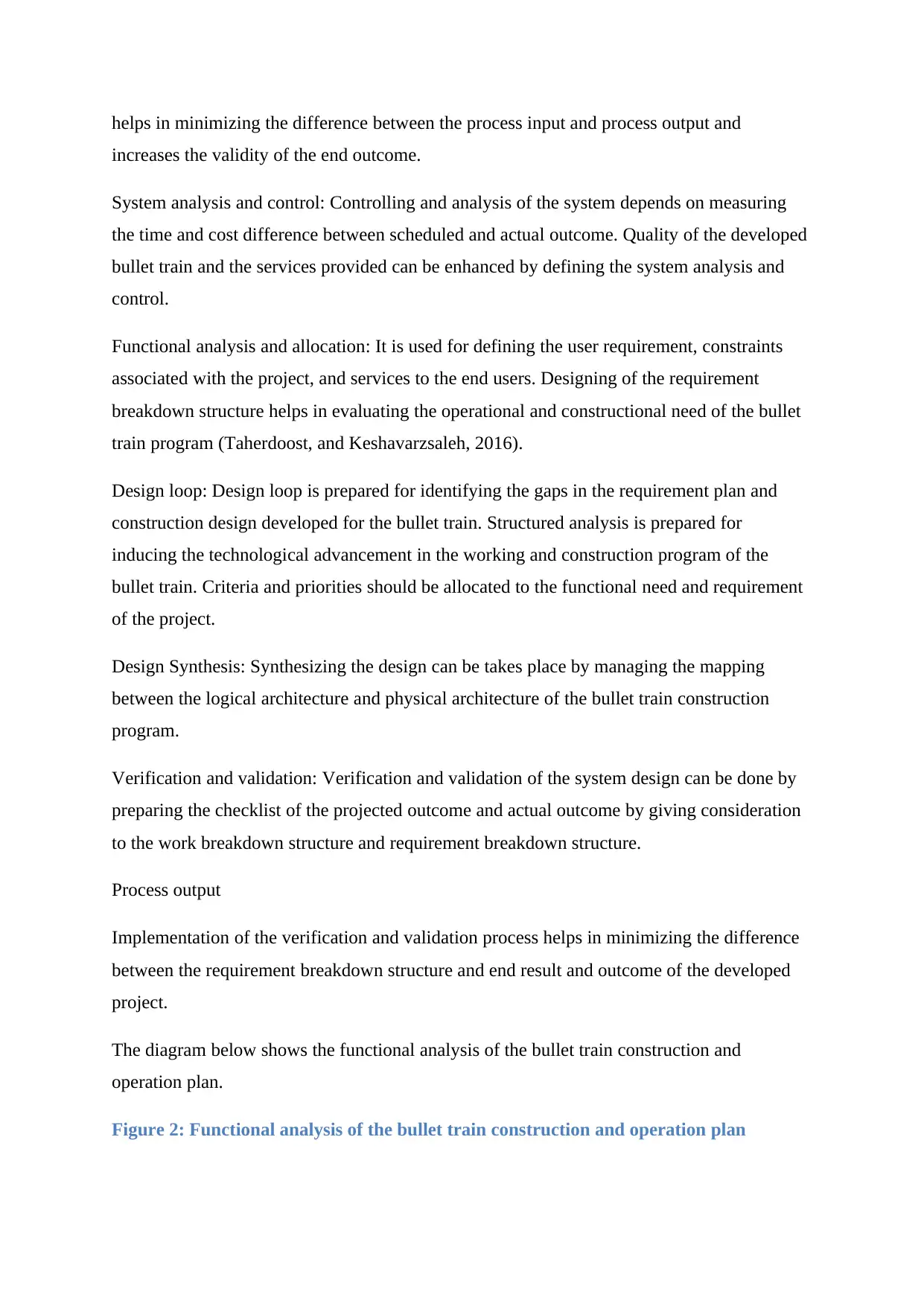
helps in minimizing the difference between the process input and process output and
increases the validity of the end outcome.
System analysis and control: Controlling and analysis of the system depends on measuring
the time and cost difference between scheduled and actual outcome. Quality of the developed
bullet train and the services provided can be enhanced by defining the system analysis and
control.
Functional analysis and allocation: It is used for defining the user requirement, constraints
associated with the project, and services to the end users. Designing of the requirement
breakdown structure helps in evaluating the operational and constructional need of the bullet
train program (Taherdoost, and Keshavarzsaleh, 2016).
Design loop: Design loop is prepared for identifying the gaps in the requirement plan and
construction design developed for the bullet train. Structured analysis is prepared for
inducing the technological advancement in the working and construction program of the
bullet train. Criteria and priorities should be allocated to the functional need and requirement
of the project.
Design Synthesis: Synthesizing the design can be takes place by managing the mapping
between the logical architecture and physical architecture of the bullet train construction
program.
Verification and validation: Verification and validation of the system design can be done by
preparing the checklist of the projected outcome and actual outcome by giving consideration
to the work breakdown structure and requirement breakdown structure.
Process output
Implementation of the verification and validation process helps in minimizing the difference
between the requirement breakdown structure and end result and outcome of the developed
project.
The diagram below shows the functional analysis of the bullet train construction and
operation plan.
Figure 2: Functional analysis of the bullet train construction and operation plan
increases the validity of the end outcome.
System analysis and control: Controlling and analysis of the system depends on measuring
the time and cost difference between scheduled and actual outcome. Quality of the developed
bullet train and the services provided can be enhanced by defining the system analysis and
control.
Functional analysis and allocation: It is used for defining the user requirement, constraints
associated with the project, and services to the end users. Designing of the requirement
breakdown structure helps in evaluating the operational and constructional need of the bullet
train program (Taherdoost, and Keshavarzsaleh, 2016).
Design loop: Design loop is prepared for identifying the gaps in the requirement plan and
construction design developed for the bullet train. Structured analysis is prepared for
inducing the technological advancement in the working and construction program of the
bullet train. Criteria and priorities should be allocated to the functional need and requirement
of the project.
Design Synthesis: Synthesizing the design can be takes place by managing the mapping
between the logical architecture and physical architecture of the bullet train construction
program.
Verification and validation: Verification and validation of the system design can be done by
preparing the checklist of the projected outcome and actual outcome by giving consideration
to the work breakdown structure and requirement breakdown structure.
Process output
Implementation of the verification and validation process helps in minimizing the difference
between the requirement breakdown structure and end result and outcome of the developed
project.
The diagram below shows the functional analysis of the bullet train construction and
operation plan.
Figure 2: Functional analysis of the bullet train construction and operation plan
You're viewing a preview
Unlock full access by subscribing today!
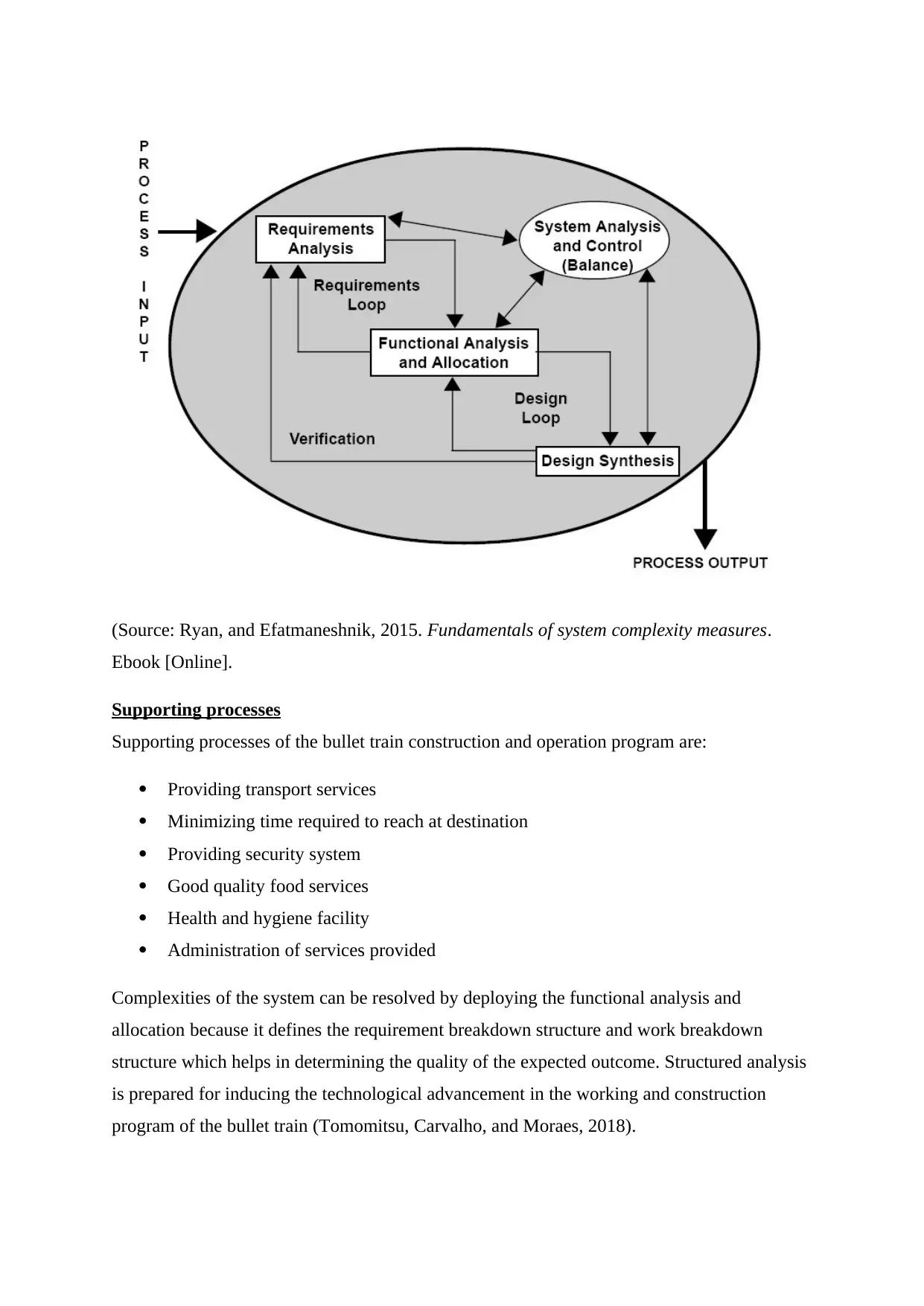
(Source: Ryan, and Efatmaneshnik, 2015. Fundamentals of system complexity measures.
Ebook [Online].
Supporting processes
Supporting processes of the bullet train construction and operation program are:
Providing transport services
Minimizing time required to reach at destination
Providing security system
Good quality food services
Health and hygiene facility
Administration of services provided
Complexities of the system can be resolved by deploying the functional analysis and
allocation because it defines the requirement breakdown structure and work breakdown
structure which helps in determining the quality of the expected outcome. Structured analysis
is prepared for inducing the technological advancement in the working and construction
program of the bullet train (Tomomitsu, Carvalho, and Moraes, 2018).
Ebook [Online].
Supporting processes
Supporting processes of the bullet train construction and operation program are:
Providing transport services
Minimizing time required to reach at destination
Providing security system
Good quality food services
Health and hygiene facility
Administration of services provided
Complexities of the system can be resolved by deploying the functional analysis and
allocation because it defines the requirement breakdown structure and work breakdown
structure which helps in determining the quality of the expected outcome. Structured analysis
is prepared for inducing the technological advancement in the working and construction
program of the bullet train (Tomomitsu, Carvalho, and Moraes, 2018).
Paraphrase This Document
Need a fresh take? Get an instant paraphrase of this document with our AI Paraphraser
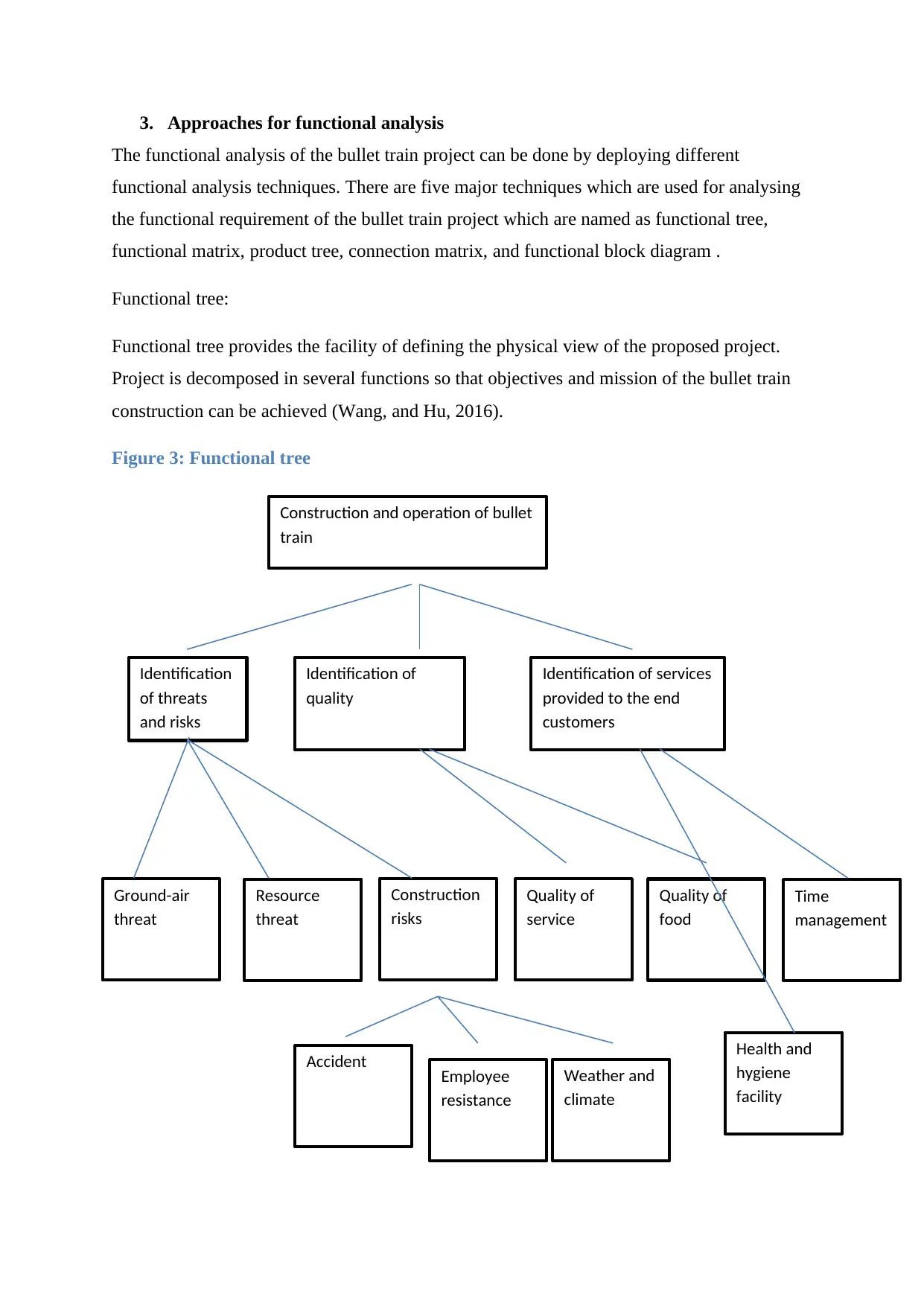
3. Approaches for functional analysis
The functional analysis of the bullet train project can be done by deploying different
functional analysis techniques. There are five major techniques which are used for analysing
the functional requirement of the bullet train project which are named as functional tree,
functional matrix, product tree, connection matrix, and functional block diagram .
Functional tree:
Functional tree provides the facility of defining the physical view of the proposed project.
Project is decomposed in several functions so that objectives and mission of the bullet train
construction can be achieved (Wang, and Hu, 2016).
Figure 3: Functional tree
Construction and operation of bullet
train
Identification
of threats
and risks
Identification of
quality
Identification of services
provided to the end
customers
Ground-air
threat
Resource
threat
Construction
risks
Quality of
service
Quality of
food
Health and
hygiene
facility
Weather and
climate
Employee
resistance
Accident
Time
management
The functional analysis of the bullet train project can be done by deploying different
functional analysis techniques. There are five major techniques which are used for analysing
the functional requirement of the bullet train project which are named as functional tree,
functional matrix, product tree, connection matrix, and functional block diagram .
Functional tree:
Functional tree provides the facility of defining the physical view of the proposed project.
Project is decomposed in several functions so that objectives and mission of the bullet train
construction can be achieved (Wang, and Hu, 2016).
Figure 3: Functional tree
Construction and operation of bullet
train
Identification
of threats
and risks
Identification of
quality
Identification of services
provided to the end
customers
Ground-air
threat
Resource
threat
Construction
risks
Quality of
service
Quality of
food
Health and
hygiene
facility
Weather and
climate
Employee
resistance
Accident
Time
management
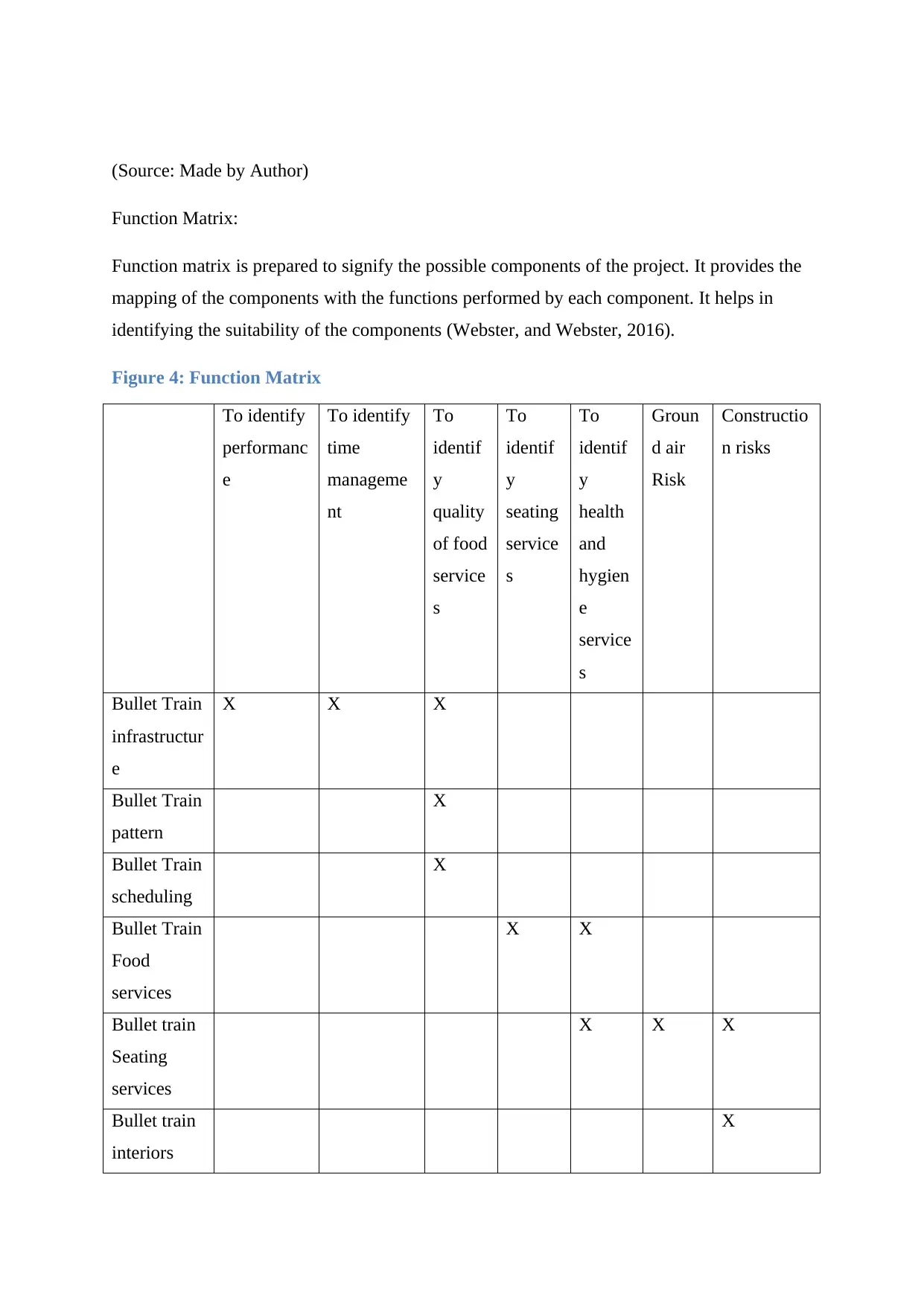
(Source: Made by Author)
Function Matrix:
Function matrix is prepared to signify the possible components of the project. It provides the
mapping of the components with the functions performed by each component. It helps in
identifying the suitability of the components (Webster, and Webster, 2016).
Figure 4: Function Matrix
To identify
performanc
e
To identify
time
manageme
nt
To
identif
y
quality
of food
service
s
To
identif
y
seating
service
s
To
identif
y
health
and
hygien
e
service
s
Groun
d air
Risk
Constructio
n risks
Bullet Train
infrastructur
e
X X X
Bullet Train
pattern
X
Bullet Train
scheduling
X
Bullet Train
Food
services
X X
Bullet train
Seating
services
X X X
Bullet train
interiors
X
Function Matrix:
Function matrix is prepared to signify the possible components of the project. It provides the
mapping of the components with the functions performed by each component. It helps in
identifying the suitability of the components (Webster, and Webster, 2016).
Figure 4: Function Matrix
To identify
performanc
e
To identify
time
manageme
nt
To
identif
y
quality
of food
service
s
To
identif
y
seating
service
s
To
identif
y
health
and
hygien
e
service
s
Groun
d air
Risk
Constructio
n risks
Bullet Train
infrastructur
e
X X X
Bullet Train
pattern
X
Bullet Train
scheduling
X
Bullet Train
Food
services
X X
Bullet train
Seating
services
X X X
Bullet train
interiors
X
You're viewing a preview
Unlock full access by subscribing today!
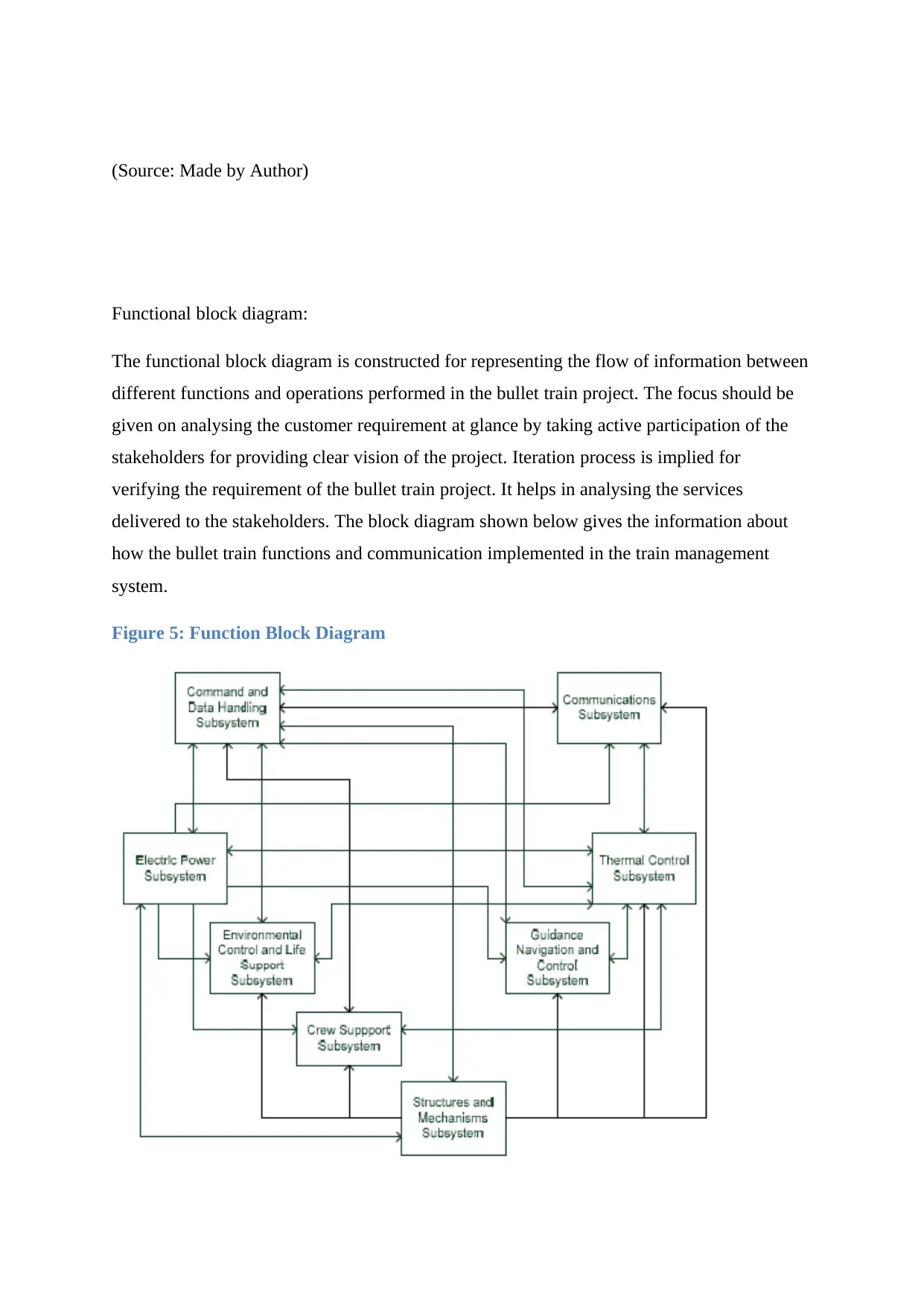
(Source: Made by Author)
Functional block diagram:
The functional block diagram is constructed for representing the flow of information between
different functions and operations performed in the bullet train project. The focus should be
given on analysing the customer requirement at glance by taking active participation of the
stakeholders for providing clear vision of the project. Iteration process is implied for
verifying the requirement of the bullet train project. It helps in analysing the services
delivered to the stakeholders. The block diagram shown below gives the information about
how the bullet train functions and communication implemented in the train management
system.
Figure 5: Function Block Diagram
Functional block diagram:
The functional block diagram is constructed for representing the flow of information between
different functions and operations performed in the bullet train project. The focus should be
given on analysing the customer requirement at glance by taking active participation of the
stakeholders for providing clear vision of the project. Iteration process is implied for
verifying the requirement of the bullet train project. It helps in analysing the services
delivered to the stakeholders. The block diagram shown below gives the information about
how the bullet train functions and communication implemented in the train management
system.
Figure 5: Function Block Diagram
Paraphrase This Document
Need a fresh take? Get an instant paraphrase of this document with our AI Paraphraser
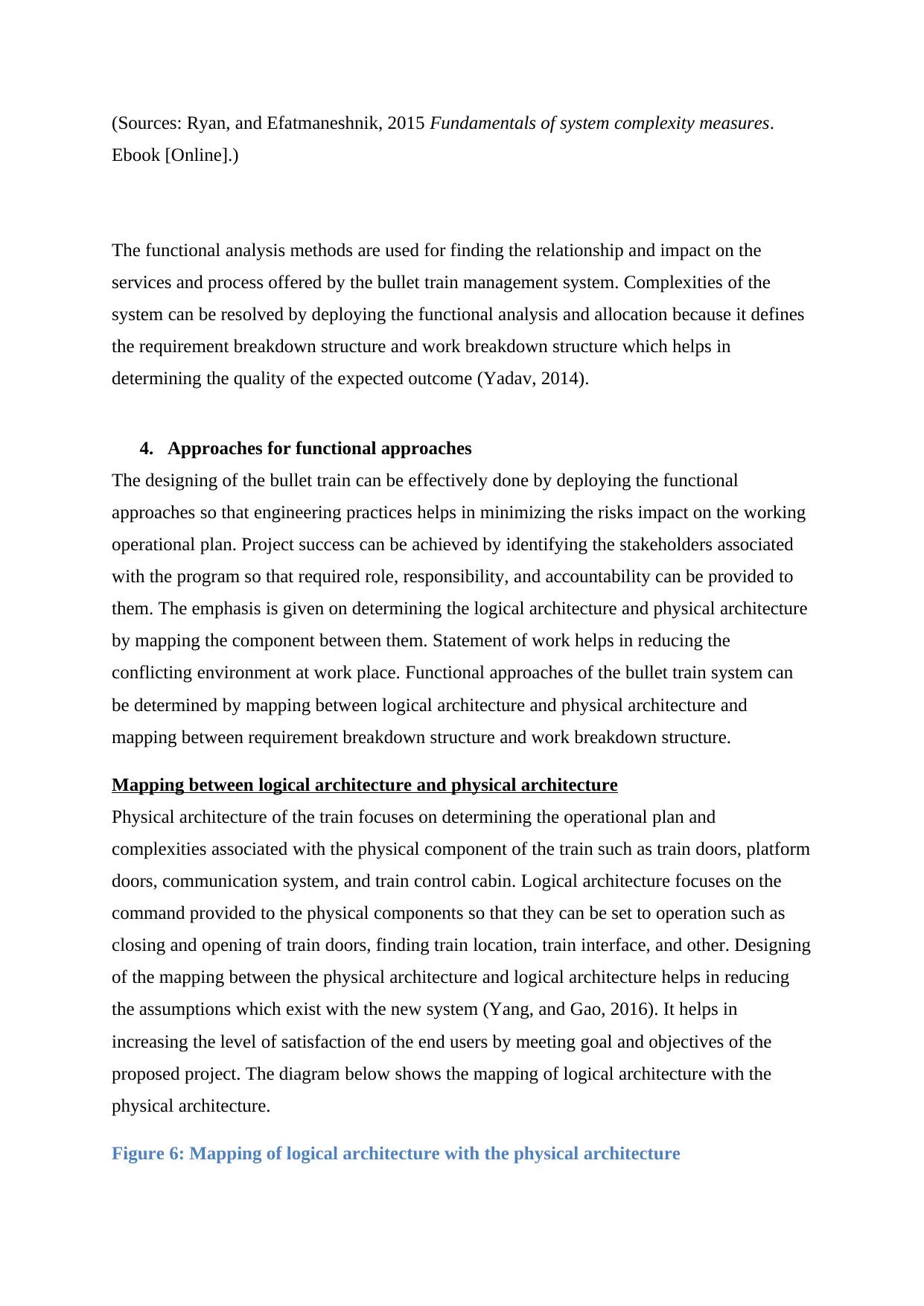
(Sources: Ryan, and Efatmaneshnik, 2015 Fundamentals of system complexity measures.
Ebook [Online].)
The functional analysis methods are used for finding the relationship and impact on the
services and process offered by the bullet train management system. Complexities of the
system can be resolved by deploying the functional analysis and allocation because it defines
the requirement breakdown structure and work breakdown structure which helps in
determining the quality of the expected outcome (Yadav, 2014).
4. Approaches for functional approaches
The designing of the bullet train can be effectively done by deploying the functional
approaches so that engineering practices helps in minimizing the risks impact on the working
operational plan. Project success can be achieved by identifying the stakeholders associated
with the program so that required role, responsibility, and accountability can be provided to
them. The emphasis is given on determining the logical architecture and physical architecture
by mapping the component between them. Statement of work helps in reducing the
conflicting environment at work place. Functional approaches of the bullet train system can
be determined by mapping between logical architecture and physical architecture and
mapping between requirement breakdown structure and work breakdown structure.
Mapping between logical architecture and physical architecture
Physical architecture of the train focuses on determining the operational plan and
complexities associated with the physical component of the train such as train doors, platform
doors, communication system, and train control cabin. Logical architecture focuses on the
command provided to the physical components so that they can be set to operation such as
closing and opening of train doors, finding train location, train interface, and other. Designing
of the mapping between the physical architecture and logical architecture helps in reducing
the assumptions which exist with the new system (Yang, and Gao, 2016). It helps in
increasing the level of satisfaction of the end users by meeting goal and objectives of the
proposed project. The diagram below shows the mapping of logical architecture with the
physical architecture.
Figure 6: Mapping of logical architecture with the physical architecture
Ebook [Online].)
The functional analysis methods are used for finding the relationship and impact on the
services and process offered by the bullet train management system. Complexities of the
system can be resolved by deploying the functional analysis and allocation because it defines
the requirement breakdown structure and work breakdown structure which helps in
determining the quality of the expected outcome (Yadav, 2014).
4. Approaches for functional approaches
The designing of the bullet train can be effectively done by deploying the functional
approaches so that engineering practices helps in minimizing the risks impact on the working
operational plan. Project success can be achieved by identifying the stakeholders associated
with the program so that required role, responsibility, and accountability can be provided to
them. The emphasis is given on determining the logical architecture and physical architecture
by mapping the component between them. Statement of work helps in reducing the
conflicting environment at work place. Functional approaches of the bullet train system can
be determined by mapping between logical architecture and physical architecture and
mapping between requirement breakdown structure and work breakdown structure.
Mapping between logical architecture and physical architecture
Physical architecture of the train focuses on determining the operational plan and
complexities associated with the physical component of the train such as train doors, platform
doors, communication system, and train control cabin. Logical architecture focuses on the
command provided to the physical components so that they can be set to operation such as
closing and opening of train doors, finding train location, train interface, and other. Designing
of the mapping between the physical architecture and logical architecture helps in reducing
the assumptions which exist with the new system (Yang, and Gao, 2016). It helps in
increasing the level of satisfaction of the end users by meeting goal and objectives of the
proposed project. The diagram below shows the mapping of logical architecture with the
physical architecture.
Figure 6: Mapping of logical architecture with the physical architecture
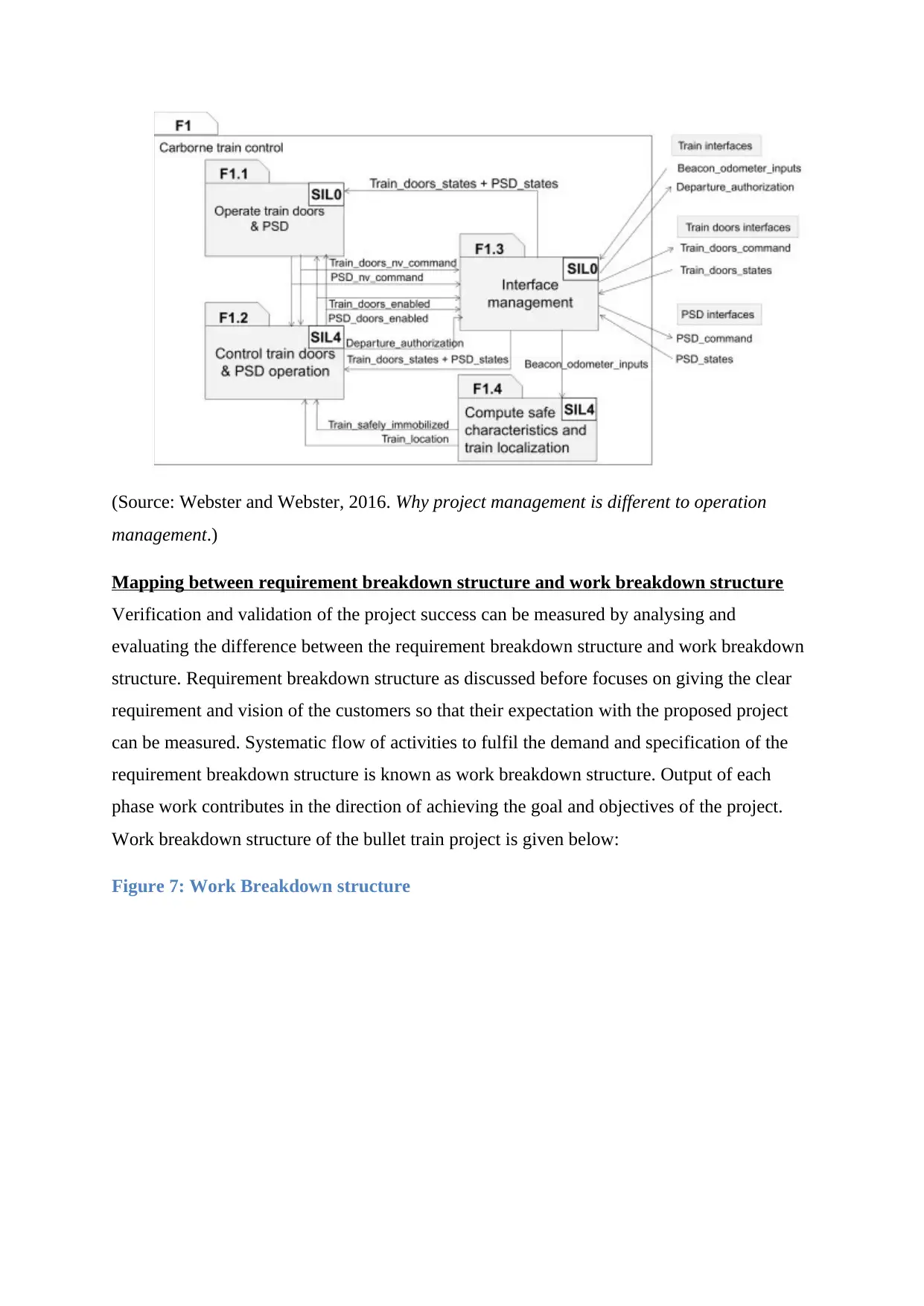
(Source: Webster and Webster, 2016. Why project management is different to operation
management.)
Mapping between requirement breakdown structure and work breakdown structure
Verification and validation of the project success can be measured by analysing and
evaluating the difference between the requirement breakdown structure and work breakdown
structure. Requirement breakdown structure as discussed before focuses on giving the clear
requirement and vision of the customers so that their expectation with the proposed project
can be measured. Systematic flow of activities to fulfil the demand and specification of the
requirement breakdown structure is known as work breakdown structure. Output of each
phase work contributes in the direction of achieving the goal and objectives of the project.
Work breakdown structure of the bullet train project is given below:
Figure 7: Work Breakdown structure
management.)
Mapping between requirement breakdown structure and work breakdown structure
Verification and validation of the project success can be measured by analysing and
evaluating the difference between the requirement breakdown structure and work breakdown
structure. Requirement breakdown structure as discussed before focuses on giving the clear
requirement and vision of the customers so that their expectation with the proposed project
can be measured. Systematic flow of activities to fulfil the demand and specification of the
requirement breakdown structure is known as work breakdown structure. Output of each
phase work contributes in the direction of achieving the goal and objectives of the project.
Work breakdown structure of the bullet train project is given below:
Figure 7: Work Breakdown structure
You're viewing a preview
Unlock full access by subscribing today!
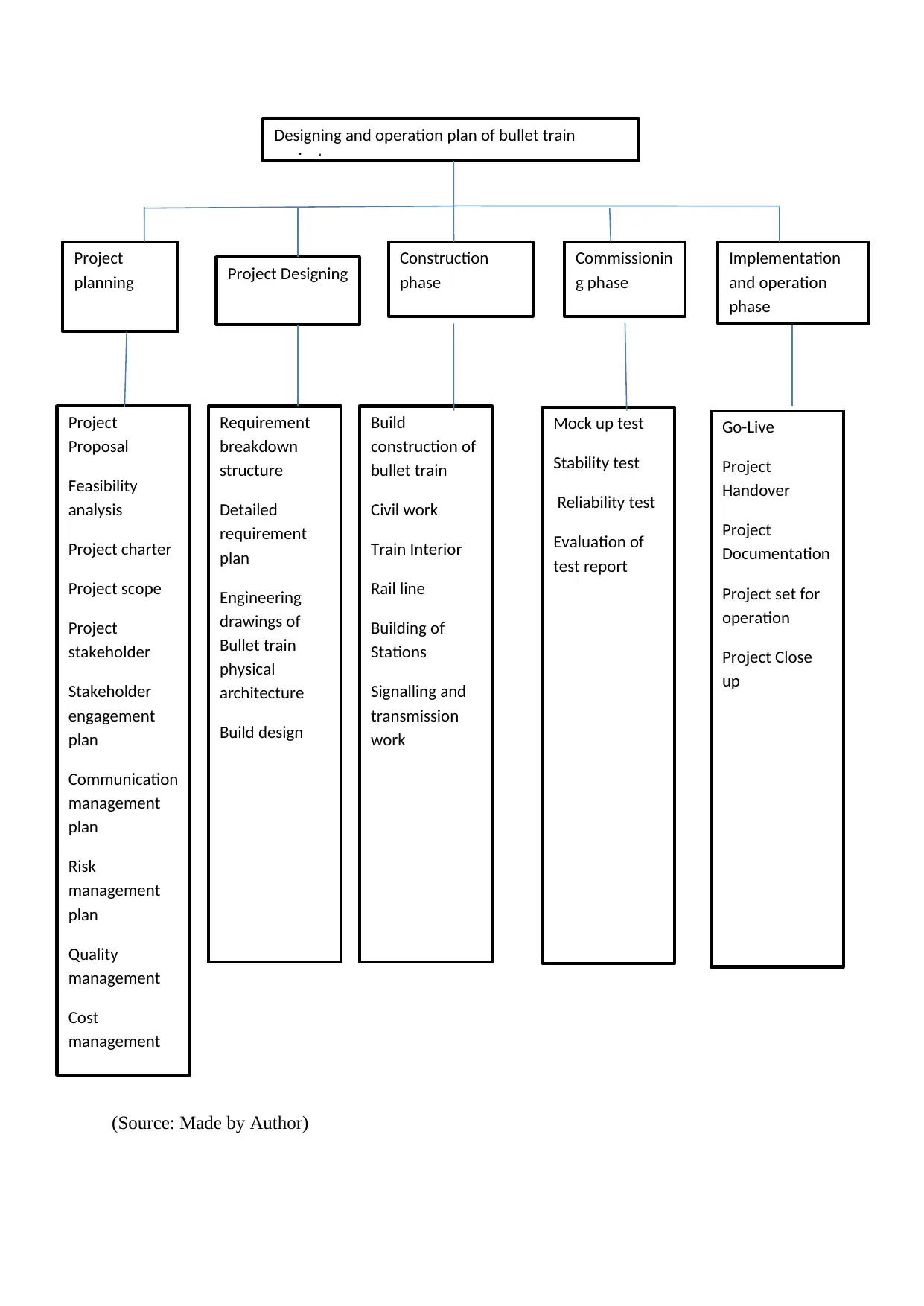
(Source: Made by Author)
Designing and operation plan of bullet train
project
Project
planning Project Designing Construction
phase
Commissionin
g phase
Implementation
and operation
phase
Project
Proposal
Feasibility
analysis
Project charter
Project scope
Project
stakeholder
Stakeholder
engagement
plan
Communication
management
plan
Risk
management
plan
Quality
management
Cost
management
Requirement
breakdown
structure
Detailed
requirement
plan
Engineering
drawings of
Bullet train
physical
architecture
Build design
Build
construction of
bullet train
Civil work
Train Interior
Rail line
Building of
Stations
Signalling and
transmission
work
Mock up test
Stability test
Reliability test
Evaluation of
test report
Go-Live
Project
Handover
Project
Documentation
Project set for
operation
Project Close
up
Designing and operation plan of bullet train
project
Project
planning Project Designing Construction
phase
Commissionin
g phase
Implementation
and operation
phase
Project
Proposal
Feasibility
analysis
Project charter
Project scope
Project
stakeholder
Stakeholder
engagement
plan
Communication
management
plan
Risk
management
plan
Quality
management
Cost
management
Requirement
breakdown
structure
Detailed
requirement
plan
Engineering
drawings of
Bullet train
physical
architecture
Build design
Build
construction of
bullet train
Civil work
Train Interior
Rail line
Building of
Stations
Signalling and
transmission
work
Mock up test
Stability test
Reliability test
Evaluation of
test report
Go-Live
Project
Handover
Project
Documentation
Project set for
operation
Project Close
up
Paraphrase This Document
Need a fresh take? Get an instant paraphrase of this document with our AI Paraphraser

5. Conclusion
It can be concluded that accuracy of the project plan can be improved by evaluating the
project requirement through functional analysis and functional approach. Mapping of
requirement breakdown structure with the work breakdown structure helps in verifying the
project success achieved in finishing task effectively. Structured analysis is prepared for
inducing the technological advancement in the working and construction program of the
bullet train. It is used for defining the user requirement, constraints associated with the
project, and services to the end users for the completion of project successfully.
6. References:
Raz, T., Shenhar, A., and Dvir, D. (2011). Risk Management, project success, and
technological uncertainty. 1st ed. [ebook]. Available at:
https://www.researchgate.net/publication/227644860_Risk_Management_Project_Success_a
nd_Technological_Uncertainty [Accessed on 02 October, 2019].
Ryan, M., and Efatmaneshnik, M. (2015). Fundamentals of system complexity measures.
Ebook [Online]. Available at:
https://www.researchgate.net/publication/274663152_Fundamentals_of_System_Complexity
_Measures [Accessed on 02 October, 2019]
Saxena, A. (2016). Avoiding project failure by using project management methodologies.
Ebook [Online]. Available at:
https://pdfs.semanticscholar.org/bbc9/f4b4e9e8959824fefd04b65dd9cc85b1606d.pdf
[Accessed on 02 October, 2019]
Sulaman, S., Weyns, K., and Host, M. (2013). A review of research on risks analysis methods
for IT system. Ebook [Online]. Available at:
https://www.researchgate.net/publication/235330202_A_Review_of_Research_on_Risk_Ana
lysis_Methods_for_IT_Systems [Accessed on 02 October, 2019]
Taherdoost, H., and Keshavarzsaleh, A. (2016). Critical factors that lead to project
success/failure in global market place. International conference on interdisciplinary in
It can be concluded that accuracy of the project plan can be improved by evaluating the
project requirement through functional analysis and functional approach. Mapping of
requirement breakdown structure with the work breakdown structure helps in verifying the
project success achieved in finishing task effectively. Structured analysis is prepared for
inducing the technological advancement in the working and construction program of the
bullet train. It is used for defining the user requirement, constraints associated with the
project, and services to the end users for the completion of project successfully.
6. References:
Raz, T., Shenhar, A., and Dvir, D. (2011). Risk Management, project success, and
technological uncertainty. 1st ed. [ebook]. Available at:
https://www.researchgate.net/publication/227644860_Risk_Management_Project_Success_a
nd_Technological_Uncertainty [Accessed on 02 October, 2019].
Ryan, M., and Efatmaneshnik, M. (2015). Fundamentals of system complexity measures.
Ebook [Online]. Available at:
https://www.researchgate.net/publication/274663152_Fundamentals_of_System_Complexity
_Measures [Accessed on 02 October, 2019]
Saxena, A. (2016). Avoiding project failure by using project management methodologies.
Ebook [Online]. Available at:
https://pdfs.semanticscholar.org/bbc9/f4b4e9e8959824fefd04b65dd9cc85b1606d.pdf
[Accessed on 02 October, 2019]
Sulaman, S., Weyns, K., and Host, M. (2013). A review of research on risks analysis methods
for IT system. Ebook [Online]. Available at:
https://www.researchgate.net/publication/235330202_A_Review_of_Research_on_Risk_Ana
lysis_Methods_for_IT_Systems [Accessed on 02 October, 2019]
Taherdoost, H., and Keshavarzsaleh, A. (2016). Critical factors that lead to project
success/failure in global market place. International conference on interdisciplinary in
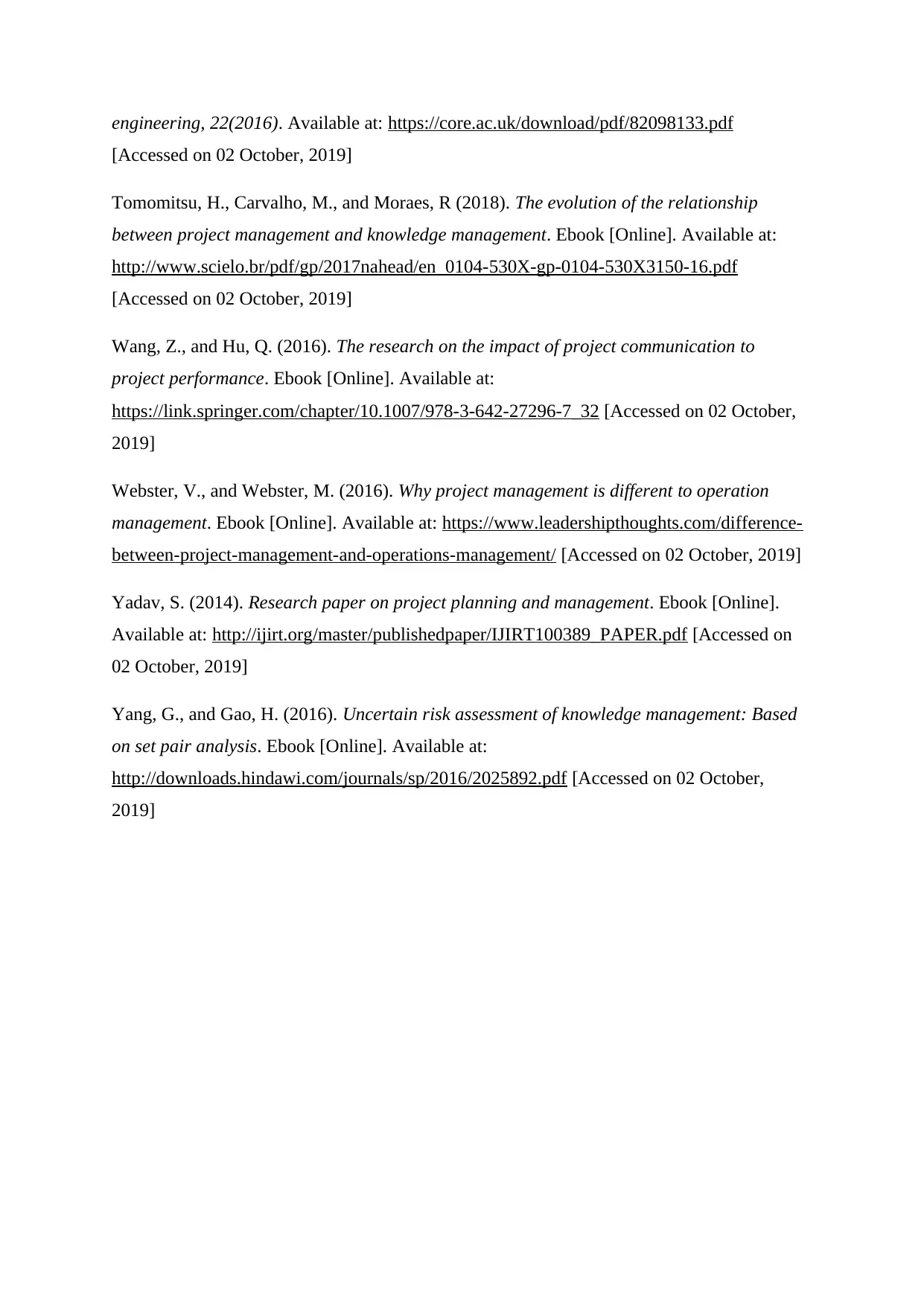
engineering, 22(2016). Available at: https://core.ac.uk/download/pdf/82098133.pdf
[Accessed on 02 October, 2019]
Tomomitsu, H., Carvalho, M., and Moraes, R (2018). The evolution of the relationship
between project management and knowledge management. Ebook [Online]. Available at:
http://www.scielo.br/pdf/gp/2017nahead/en_0104-530X-gp-0104-530X3150-16.pdf
[Accessed on 02 October, 2019]
Wang, Z., and Hu, Q. (2016). The research on the impact of project communication to
project performance. Ebook [Online]. Available at:
https://link.springer.com/chapter/10.1007/978-3-642-27296-7_32 [Accessed on 02 October,
2019]
Webster, V., and Webster, M. (2016). Why project management is different to operation
management. Ebook [Online]. Available at: https://www.leadershipthoughts.com/difference-
between-project-management-and-operations-management/ [Accessed on 02 October, 2019]
Yadav, S. (2014). Research paper on project planning and management. Ebook [Online].
Available at: http://ijirt.org/master/publishedpaper/IJIRT100389_PAPER.pdf [Accessed on
02 October, 2019]
Yang, G., and Gao, H. (2016). Uncertain risk assessment of knowledge management: Based
on set pair analysis. Ebook [Online]. Available at:
http://downloads.hindawi.com/journals/sp/2016/2025892.pdf [Accessed on 02 October,
2019]
[Accessed on 02 October, 2019]
Tomomitsu, H., Carvalho, M., and Moraes, R (2018). The evolution of the relationship
between project management and knowledge management. Ebook [Online]. Available at:
http://www.scielo.br/pdf/gp/2017nahead/en_0104-530X-gp-0104-530X3150-16.pdf
[Accessed on 02 October, 2019]
Wang, Z., and Hu, Q. (2016). The research on the impact of project communication to
project performance. Ebook [Online]. Available at:
https://link.springer.com/chapter/10.1007/978-3-642-27296-7_32 [Accessed on 02 October,
2019]
Webster, V., and Webster, M. (2016). Why project management is different to operation
management. Ebook [Online]. Available at: https://www.leadershipthoughts.com/difference-
between-project-management-and-operations-management/ [Accessed on 02 October, 2019]
Yadav, S. (2014). Research paper on project planning and management. Ebook [Online].
Available at: http://ijirt.org/master/publishedpaper/IJIRT100389_PAPER.pdf [Accessed on
02 October, 2019]
Yang, G., and Gao, H. (2016). Uncertain risk assessment of knowledge management: Based
on set pair analysis. Ebook [Online]. Available at:
http://downloads.hindawi.com/journals/sp/2016/2025892.pdf [Accessed on 02 October,
2019]
You're viewing a preview
Unlock full access by subscribing today!
1 out of 15
Related Documents
Your All-in-One AI-Powered Toolkit for Academic Success.
+13062052269
info@desklib.com
Available 24*7 on WhatsApp / Email
![[object Object]](/_next/static/media/star-bottom.7253800d.svg)
Unlock your academic potential
© 2024 | Zucol Services PVT LTD | All rights reserved.





